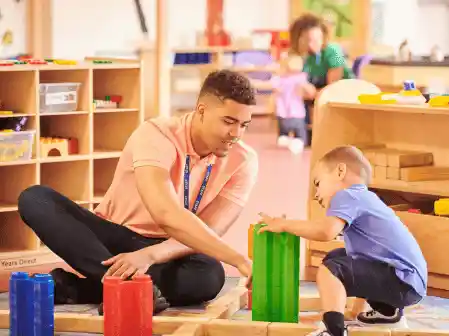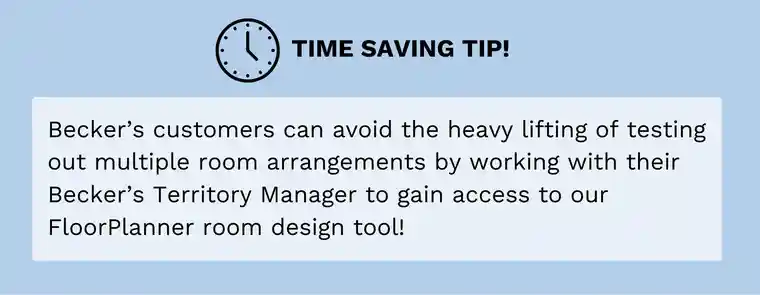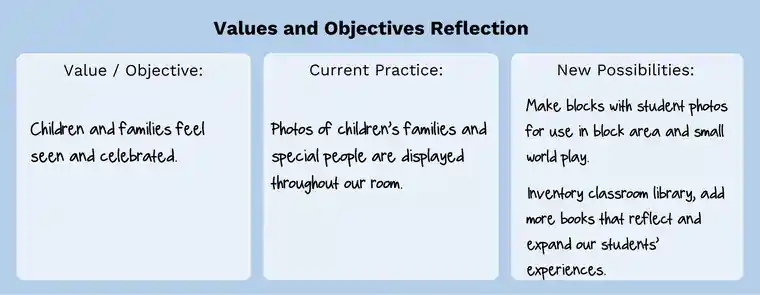Intentionally Preparing Preschool Environments

Planning for Wonder: Intentionally Preparing Preschool and Pre-K Environments
Dreaming about the year ahead is exciting and inspiring! If we’re honest, it can sometimes feel overwhelming too. Your head might be swimming with a new class list, scheduling changes, curriculum updates, and a wish list of new materials. It can be tricky to figure out where to start! Thinking through your room set-up can be an effective anchor in the process of back-to-school planning. Early learning environments set the stage for students’ experiences. Let’s plan for an environment that supports our ultimate goal: to create settings that support joyful and wonder-filled learning experiences for all children.
Each early learning context has its own unique considerations. Licensing, accreditation, curriculum, and individual program philosophy and policies all come with their own set of requirements. Before the new year starts, it’s important to make sure you’re up to date on the latest regulations and guidelines that apply to your setting.
Creating “Yes Environments”
An ideal learning space meets learners right where they are with space to help them stretch and grow. Of course, this is ever challenging as a room full of preschoolers is also full of varying needs, abilities, and interests. Start with safety, making sure your space, furniture, and materials are in good repair and meet safety guidelines. While planning furniture arrangement, check for tipping and or sightline obstacles. Once teachers are confident that an environment is safe, it is easier to relax into a mindset that encourages exploration and curiosity.
Laying the Foundation
Thoughtful furniture arrangement creates the foundation for a welcoming, safe and functional classroom. It might be helpful to list each center that you will include and create an inventory of materials you’ll need for each space. You’re sure to find the set up that works best for you and your students, but some general considerations can guide your process:
- Where will you gather as a large group?
- Are your art and sensory areas close to the sink?
- Think about traffic flow! Are there areas that are likely to get congested or other areas that you want to invite children towards?
- Wide open paths invite running. Let your furniture work with you so that you have logical pathways that encourage safe movement throughout the room.
- What interest areas tend to be active and noisy, and which are ideal for quieter activities? Can you organize your space to support this balance?
- Is there space for group projects and collaboration as well as solo play or cozy time?
- Don’t forget meals and rest time. Be sure your room arrangement accommodates the necessary provisions for all parts of your day.

Planning for Success:
Introducing Materials with Intention
The beginning of the year can sometimes feel like starting over. As a teacher, your most recent memories may be from the previous year when your students could navigate your classroom and materials as experts! As you prepare to welcome your new class, each area will need to be reset for the ages and experiences of your incoming students. “Less is more” is rarely a more accurate saying than at the beginning of the year! While a shelf packed full of inviting materials might seem appealing to some adult eyes, it can be overwhelming and frustrating for children, and often overwhelming and frustrating for teachers in turn.
So, how to start?
Begin with the basics. Think about the primary function of each interest area and provide the materials that offer the foundation of the experience. For example, your block area might launch simply, with basic unit blocks on clearly labeled shelves, a basket of vehicles, and a basket of block people. Once these materials are introduced, and their care and use are explained, give children time to become experts in that area. Thoughtful observation will help you have a sense of when your students are ready for more. As children become acclimated to their space and materials, here are some questions to consider:
- Is there conflict over scarcity, or is the quantity of materials just right to support opportunities for sharing and collaboration?
- What specific accessories could expand the complexity and creativity of children’s play?
- What questions do you notice the children asking? Are there materials or tools that you can add to your interest center to facilitate exploration that aligns with their interests?
- Could open-ended materials support children’s experiences across multiple interest areas?
As you tune in to how children are using their space, opportunities for extending their experiences will become clear. Just be sure you continue to introduce materials as they are added, being explicit about the expectations for care and safe use. A simple schedule can help you organize and set aside enough time to gather materials and add their introduction to your lesson planning. Having this on paper (saved digitally) also comes in handy later in the year as you plan to rotate materials.
“What if my curriculum, accreditation, or quality rating tool requires specific quantities of materials in each area?”
Collaborate with your program leaders to plan. Most assessments offer provisions for the gradual introduction of materials at the beginning of the year. Make a schedule of materials you plan to introduce to each center. This will help you stay on track to meet the requirements by the agreed upon time.
Let’s Be Reflective

Gathering our thoughts about previous experiences can help us plan for the new school year with purpose and intention. Like so many aspects of a teaching practice, the cycle of observation and reflection supports the design of a thoughtful, responsive learning space that grows and changes as children’s needs, abilities, and interests evolve. Download Becker’s Reflective Planning Guide for Preschool Environments for prompts to align your planning and purpose, reflect on your interest areas, and assess your current materials.
Ready to Learn More?
Did you miss our two Back to School planning webinars? No problem! You can watch the recordings and download all the resources - click on one of the images below!

Christine Murray is an Early Childhood Education Specialist with Becker’s Education Team.
As an educator, coach and leader, Christine is inspired by the curiosity, joy and wonder that children so generously model for us. She earned her M.A. in Innovative Early Childhood Education at the University of Colorado Denver and loves collaborating with and supporting others in the field. Grounded in relationships and guided by empathy, Christine is always learning, connecting and creating.


